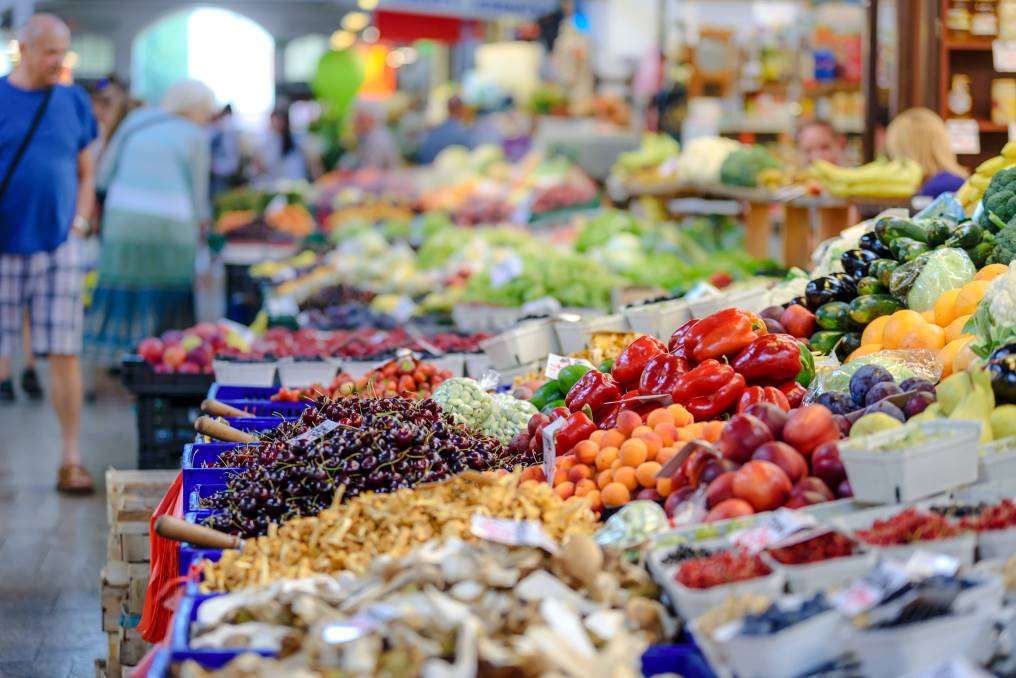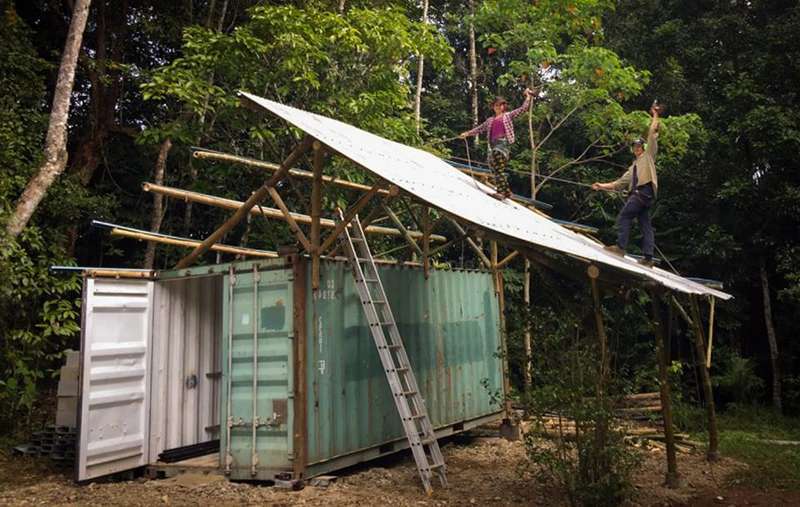Hello there! In this article, we’ll be discussing Japan’s food self-sufficiency and exploring whether they are able to meet their own food demands. To give you more context about the subject, we’ll touch upon off-grid living and provide you with some interesting content. So stick around and let’s find out if Japan is self-sufficient in food!
Exploring Japan’s Food Self-Sufficiency

Overview of Japan’s Food Self-Sufficiency
Japan’s food self-sufficiency refers to the country’s ability to produce enough food domestically to meet its own consumption demands. Food self-sufficiency is an important aspect of national security and economic stability, as it reduces reliance on external sources and ensures food availability during times of crisis. However, Japan has historically faced challenges in achieving high levels of food self-sufficiency due to its limited land resources, natural disasters, and a highly urbanized population.
Factors Influencing Food Self-Sufficiency
Several factors have influenced Japan’s food self-sufficiency over the years. The country’s mountainous terrain and limited arable land pose significant challenges to agricultural production. Additionally, frequent natural disasters like earthquakes, tsunamis, and typhoons further impact crop yield and infrastructure. Rapid industrialization and urbanization have also resulted in the conversion of agricultural land for urban development, reducing the overall production capacity.
Importance of Food Self-Sufficiency in Japan
Food self-sufficiency holds great importance for Japan, given its vulnerability to external factors and the necessity to ensure a stable food supply for its population. With a growing global population and increasing competition for resources, relying heavily on food imports poses risks in terms of price fluctuations, supply chain disruptions, and geopolitical tensions. Therefore, achieving a higher level of food self-sufficiency is essential to protect the country’s food security and reduce dependence on imports.
Challenges to Achieving Food Self-Sufficiency
While Japan has made efforts to improve its food self-sufficiency, several challenges persist. Limited arable land availability remains a significant obstacle, necessitating innovative farming practices and efficient land utilization. The aging farming population is another concern, as it leads to a decline in agricultural workforce and a lack of interest among younger generations in pursuing farming as a career. Additionally, changing dietary preferences towards Western-style diets, which require a greater variety of imported food, pose challenges to increasing self-sufficiency.
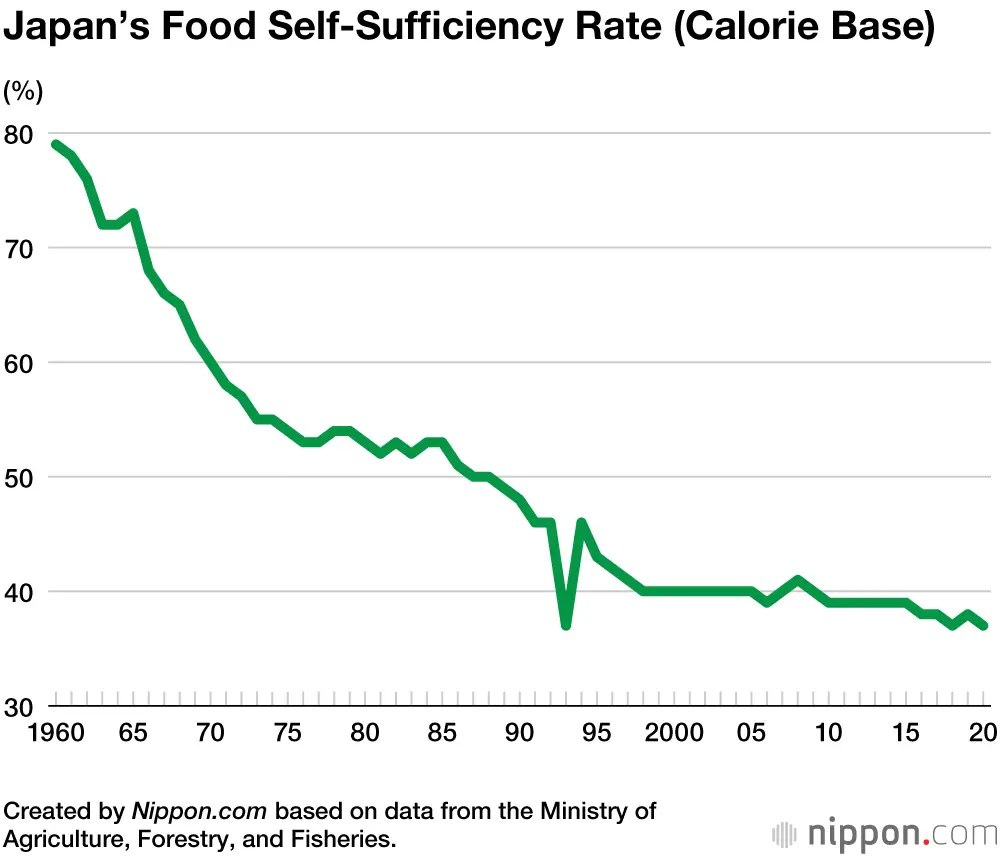
Agricultural Landscape of Japan
Traditional Farming Practices in Japan
Japan has a rich agricultural heritage characterized by traditional farming practices deeply rooted in its culture. Historically, rice cultivation has been a staple agricultural activity, with small-scale, family-run farms prevalent across the countryside. Traditional farming methods have emphasized sustainable practices, including crop rotation, natural fertilizers, and integrated pest management. These practices have been vital in maintaining environmental balance and preserving the unique quality and flavor of Japanese agricultural produce.
Modernization of Agriculture
In recent decades, Japan has witnessed the modernization of its agricultural sector. Technological advancements and government initiatives have aimed to enhance productivity, improve efficiency, and overcome the challenges associated with limited land resources. Mechanization and automation have been introduced to streamline farming operations and reduce labor requirements. High-tech agricultural machinery and precision farming techniques, such as GPS-guided tractors and drones, have revolutionized the way crops are grown and harvested.
Types of Crops Grown in Japan
Japan’s diverse climate and topography support the cultivation of a wide range of crops. Rice remains a fundamental staple, but other crops like wheat, barley, soybeans, and vegetables are also grown in large quantities. Fruits, including apples, oranges, grapes, and melons, are cultivated in various regions. Seafood, especially fish and seaweed, also plays a significant role in Japan’s food production. The cultivation of unique Japanese products like green tea, wasabi, and Japanese mushrooms is also celebrated and contributes to the country’s culinary heritage.
Government Initiatives and Policies
The Japanese Agricultural Cooperatives System
Japan’s agriculture sector is supported by a cooperative system known as Nokyo, which consists of local agricultural cooperatives across the country. These cooperatives provide farmers with various services, including marketing, distribution, financial assistance, and training programs. Nokyo acts as a bridge between farmers and consumers, ensuring fair pricing and quality control while promoting sustainable agricultural practices.
Subsidies and Support for Farmers
The Japanese government offers subsidies and support programs to farmers to encourage domestic food production and improve food self-sufficiency. Financial assistance, tax incentives, and low-interest loans are provided to enhance agricultural infrastructure, invest in modern farming technologies, and support farmers in their operations. These initiatives aim to boost productivity and competitiveness within the agricultural sector while improving the livelihoods of farmers.
Promotion of Agricultural Innovation
Recognizing the need for innovation in agriculture, the Japanese government promotes research and development in the sector. Collaborations between universities, research institutions, and agricultural businesses drive technological advancements and the adoption of sustainable farming methods. Cutting-edge technologies, such as artificial intelligence (AI), Internet of Things (IoT), and robotics, are being utilized to optimize crop management, minimize resource use, and increase overall productivity.

Food Imports and Exports
Japan’s Reliance on Food Imports
Japan heavily relies on food imports to meet its consumption demands. Due to limited domestic production capacity and a growing population, the country imports a significant portion of its food, including grains, meat, dairy products, and fruits. While imports play a crucial role in diversifying the food supply and meeting consumer preferences, reducing dependence on imports is a key priority for achieving higher levels of food self-sufficiency.
Major Import and Export Partners
Japan’s major food import partners include the United States, Australia, China, and other Asian countries. These countries supply a wide range of agricultural products, such as wheat, beef, pork, dairy, and fruits. On the export front, Japan is known for its high-quality agricultural products like Wagyu beef, seafood, green tea, and sake. The export market provides opportunities for Japanese farmers to expand their businesses and promote Japanese cuisine and culture globally.
Impact of Trade Agreements on Food Self-Sufficiency
Trade agreements play a significant role in shaping Japan’s food self-sufficiency. International trade liberalization through agreements like the Trans-Pacific Partnership (TPP) and the Japan-EU Economic Partnership Agreement (JEFTA) has opened up new avenues for agricultural trade. While these agreements enhance market access for Japanese products, they also expose domestic farmers to increased competition from imports. Striking a balance between promoting trade and protecting domestic agriculture remains a crucial challenge for policymakers.
Regional Disparities in Food Self-Sufficiency
Differences in Agricultural Productivity
Food self-sufficiency levels vary across different regions in Japan due to differences in agricultural productivity. The Tohoku and Hokkaido regions, with their vast farmlands and favorable climate conditions, have higher levels of self-sufficiency. On the other hand, densely populated areas like Tokyo and Osaka heavily rely on food imports due to limited agricultural land availability. Addressing regional disparities requires targeted policies and investments to increase production capacity in regions with lower self-sufficiency.
Rural vs Urban Food Production
The rapid urbanization of Japan has resulted in a shift in food production from rural areas to urban centers. Urban farming initiatives, such as rooftop gardens, vertical farming, and hydroponics, have gained popularity in cities, contributing to local food production. However, these initiatives alone cannot meet urban food demands, and a balance between urban and rural production is crucial in achieving higher levels of self-sufficiency. Encouraging collaboration between urban and rural areas can lead to more sustainable and resilient food systems.
Efforts to Improve Regional Food Security
To improve regional food security, local governments and organizations have taken various initiatives. They promote the consumption of locally grown produce through campaigns, support farmers’ markets and co-ops, and establish networks connecting producers with consumers. Educational programs in schools also raise awareness about the importance of local food and encourage sustainable farming practices. These efforts not only enhance food self-sufficiency but also strengthen the bond between producers and consumers, fostering community resilience.
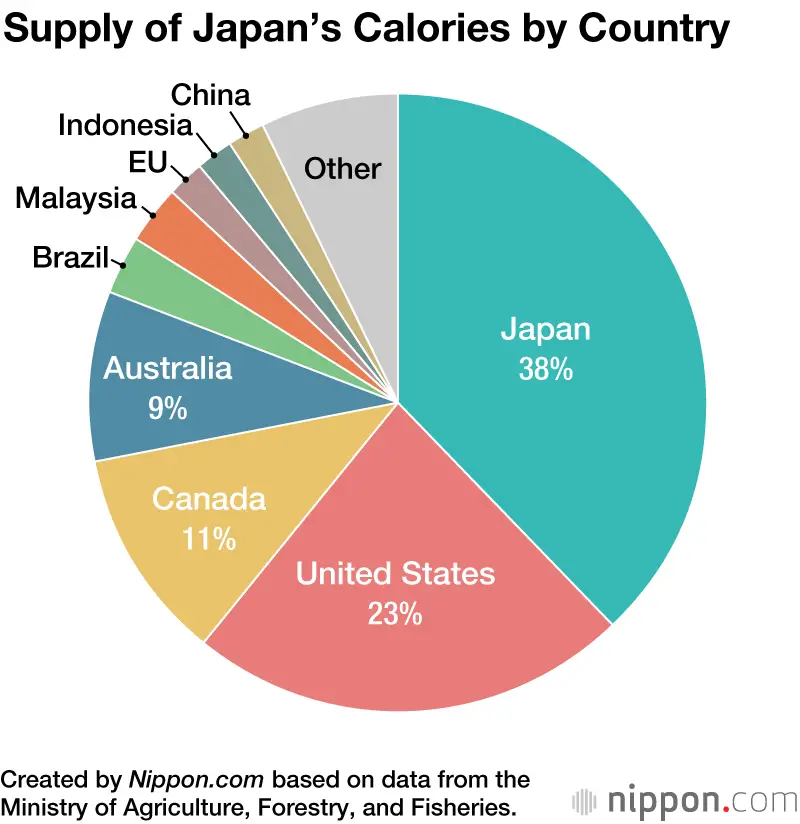
Sustainable Agriculture Practices
Organic Farming in Japan
Organic farming has gained popularity in recent years as consumers prioritize healthy and environmentally-friendly food choices. Japan has a strong organic farming sector, and the government supports organic certification systems and provides subsidies to promote organic practices. Organic farming utilizes natural fertilizers, avoids chemical pesticides, and emphasizes soil health and biodiversity conservation. It plays a crucial role in sustainable agriculture and contributes to the overall goal of achieving higher food self-sufficiency.
Efficiency in Water and Energy Use
Given Japan’s limited land and resource constraints, efficient water and energy use in agriculture become paramount. The government encourages the adoption of advanced irrigation systems, water-saving technologies, and efficient energy sources to minimize resource wastage. Drip irrigation, rainwater collection, and recycling systems are used to conserve water, while renewable energy sources, such as solar power, are increasingly being utilized on farms. These practices not only reduce the environmental impact but also improve the economic viability of agriculture.
Promotion of Sustainable Farming Methods
Sustainable farming methods, such as permaculture, agroforestry, and integrated farming systems, are gaining momentum in Japan. These techniques focus on maximizing resource efficiency, enhancing biodiversity, and minimizing environmental impact. Agroecology principles, including natural pest control, crop diversification, and soil conservation, are incorporated into farming practices. By promoting sustainable farming methods, Japan aims to create resilient agricultural systems that can adapt to climate change and ensure long-term food security.
Rising Food Trends in Japan
Increase in Locally-Produced Food
There has been a growing trend in Japan towards consuming locally-produced food. Consumers are becoming more conscious of where their food comes from, valuing freshness, quality, and supporting local farmers. Farmers‘ markets and direct-to-consumer sales channels have witnessed increased popularity, providing an avenue for consumers to access local produce while establishing a direct connection with farmers. This shift towards locally-produced food contributes to strengthening food self-sufficiency and promoting a sustainable food system.
Demand for Healthy and Organic Products
Health-consciousness has been on the rise in Japan, leading to an increased demand for healthy and organic food products. Consumers are opting for pesticide-free, non-genetically modified, and chemical-free food options that prioritize nutrition and well-being. This demand for healthier choices presents an opportunity for local farmers to diversify their production and cater to niche markets. Meeting the demand for healthy and organic products not only enhances food self-sufficiency but also improves the overall health of the population.
Emerging Food Technologies
Technological innovations have begun to shape the food landscape in Japan. With the advancement of food technology, alternatives to conventional agriculture are emerging. Vertical farming, hydroponics, and cellular agriculture are revolutionizing the way food is produced. These technologies enable year-round cultivation, reduce resource consumption, and offer solutions for urban food production. While these innovations are still in their early stages, they have the potential to contribute to Japan’s food self-sufficiency in the future.
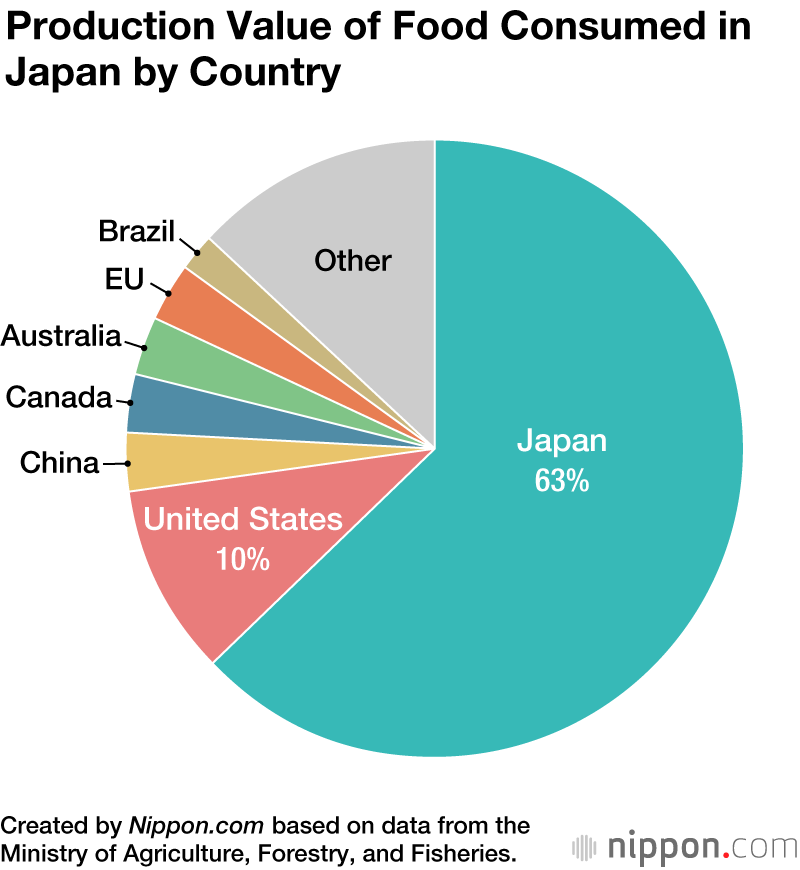
Cultural Significance of Food
Traditional Japanese Cuisine
Food plays a vital role in Japanese culture, with traditional cuisine being deeply ingrained in everyday life. Washoku, the traditional Japanese cuisine, emphasizes the use of seasonal ingredients, preserving the natural flavors and nutritional value of the food. The emphasis on balance, presentation, and harmony reflects Japan’s respect for nature and appreciation for the culinary arts. Preserving traditional food practices and supporting local producers contributes to cultural heritage and strengthens Japan’s food self-sufficiency.
Food as a Reflection of Cultural Heritage
Japanese food reflects the country’s rich cultural heritage and is an important part of its identity. Various regional specialties, local ingredients, and cooking techniques showcase the diversity of Japan’s culinary traditions. By promoting indigenous food products and culinary traditions, Japan preserves its cultural heritage, stimulates regional economies, and reinforces the notion of food self-sufficiency.
Celebration of Seasonal Ingredients
Seasonality holds great significance in Japanese cuisine, with each season bringing forth unique ingredients and flavors. The celebration of seasonal ingredients not only ensures freshness and nutritional value but also strengthens the agricultural and culinary traditions. Seasonal festivals, such as cherry blossom viewing parties in spring and moon-viewing gatherings in autumn, showcase the connection between food, nature, and cultural festivities. Appreciating and consuming seasonal produce contributes to a more sustainable and self-sufficient food system.
Community-Based Food Systems
Role of Farmers’ Markets and Co-ops
Farmers’ markets and agricultural cooperatives (JA) play a crucial role in Japan’s community-based food systems. Farmers’ markets provide a direct link between farmers and consumers, encouraging the consumption of locally-produced food. These markets not only offer fresh, seasonal produce but also create a sense of community and foster relationships between producers and consumers. Agricultural cooperatives, on the other hand, facilitate collective marketing, distribution, and support services, ensuring fair returns for farmers and enhancing local food self-sufficiency.
Community Gardens and Urban Farming
Community gardens and urban farming initiatives have gained popularity in Japan’s urban areas. These projects allow residents to grow their own food, reconnect with nature, and contribute to local food production. Community gardens provide educational opportunities, particularly for children, teaching them about the origins of food and promoting sustainable practices. Urban farming initiatives, which utilize vacant lots, rooftops, and indoor spaces, play a vital role in increasing local food self-sufficiency while enhancing community resilience.
Collaboration Between Producers and Consumers
Collaboration between producers and consumers is key to building a sustainable and self-sufficient food system. Initiatives such as community-supported agriculture (CSA) and direct sales programs promote direct interaction between farmers and consumers. Consumers can purchase shares or subscriptions from local farmers and receive regular deliveries of fresh produce. This system not only establishes a direct connection but also ensures fair prices for farmers and supports local agriculture.
Food Waste and Sustainability
Efforts to Minimize Food Loss and Waste
Minimizing food loss and waste is a critical aspect of achieving sustainable food self-sufficiency. Japan has implemented various measures to combat food waste, including educational campaigns, improvement of supply chain efficiency, and the introduction of food waste recycling systems. Food distribution networks and supermarkets encourage the donation of surplus food to local food banks and organizations. These efforts not only reduce waste but also address food insecurity and enhance the overall sustainability of the food system.
Food Redistribution and Donation Programs
Food redistribution and donation programs have gained prominence in Japan as a means to tackle food waste and support vulnerable communities. Various organizations facilitate the collection and distribution of surplus food from producers, retailers, and restaurants to those in need. These initiatives ensure that edible food is redirected for human consumption, reducing waste while addressing food security issues. Collaborative efforts between the government, businesses, and non-profit organizations have been instrumental in promoting food redistribution and creating a more sustainable food system.
Promoting a Circular Economy
Promoting a circular economy is a key element in Japan’s efforts to enhance food self-sufficiency and sustainability. Developing a closed-loop system where waste is minimized, resources are efficiently utilized, and by-products are repurposed helps reduce environmental impact. Innovative practices such as composting food waste, utilizing agricultural residues for energy production, and converting food waste into animal feed contribute to a more circular and sustainable food system.
Technological Innovations in Agriculture
Advancements in Farming Machinery
Technological advancements in farming machinery have transformed Japan’s agricultural sector. High-tech machinery, such as automated planters, harvesters, and robotic systems, reduce labor requirements and increase efficiency. GPS-guided tractors and drones enable precise and optimized crop management, minimizing resource use and enhancing productivity. These advancements not only improve the economic viability of farming but also attract younger generations to the profession by showcasing the potential for high-tech careers in agriculture.
Smart Farming and Precision Agriculture
Smart farming and precision agriculture technologies have revolutionized the way crops are cultivated and managed. Sensor technologies, remote monitoring systems, and data analytics provide real-time information on soil conditions, plant health, and climate, enabling farmers to make informed decisions. By precisely applying water, fertilizers, and pesticides, farmers can reduce resource wastage and optimize crop yield. These technologies have the potential to significantly enhance the efficiency and sustainability of Japan’s agricultural industry.
Application of AI and IoT in Agriculture
The application of artificial intelligence (AI) and the Internet of Things (IoT) in agriculture has immense potential to improve productivity and sustainability. AI algorithms can analyze complex data sets and provide insights for optimized crop management, disease detection, and yield prediction. IoT devices, such as soil moisture sensors and automated irrigation systems, allow for precise monitoring and control, reducing resource waste. Integrating AI and IoT technologies into agricultural practices empowers farmers with real-time information and decision-making tools, thereby increasing efficiency and contributing to food self-sufficiency.
Impacts of Climate Change
Climate Change Effects on Agriculture
Climate change poses significant challenges to Japan’s agricultural sector. Rising temperatures, increased frequency of extreme weather events, and changing precipitation patterns disrupt crop growth and productivity. Pests and diseases may also increase due to changing climatic conditions. Moreover, rising sea levels and saltwater intrusion threaten agricultural land in coastal regions. Adapting to these climate change impacts requires innovative farming practices, resilient crop varieties, and effective water management systems.
Adaptation and Mitigation Strategies
To mitigate and adapt to the impacts of climate change, Japan has implemented various strategies. Climate-smart agriculture practices, such as conservation agriculture, agroforestry, and water-efficient irrigation, are promoted to reduce greenhouse gas emissions and enhance climate resilience. Crop diversification, introduction of heat-tolerant and disease-resistant varieties, and enhancing crop rotation help mitigate climate-related risks and maintain agricultural productivity. Implementation of risk management measures, such as insurance coverage for farmers, further strengthens the sector’s resilience.
Resilience Building in the Food System
Building resilience within the food system is crucial in the face of climate change. Japan focuses on enhancing the resilience of producers, consumers, and the entire value chain. Increasing the diversity of crops, supporting traditional and local varieties, and investing in infrastructure to protect against natural disasters are key strategies. Developing climate-resilient supply chains, investing in renewable energy sources, and raising awareness about the impacts of climate change across the food system contribute to the overall goal of achieving long-term food self-sufficiency in a changing climate.
Collaboration and Partnerships
Government-Private Sector Collaboration
Collaboration between the government and the private sector plays a vital role in promoting food self-sufficiency in Japan. Public-private partnerships facilitate knowledge sharing, technology transfer, and joint investments in the agricultural sector. The government provides policy support, funding, and infrastructure development, while the private sector brings in expertise, innovation, and market access. Through these collaborations, Japan can leverage resources and expertise to address challenges and enhance agricultural productivity.
International Cooperation on Food Security
Recognizing the global nature of food security challenges, Japan actively participates in international cooperation efforts. The country is involved in initiatives such as the United Nations’ Sustainable Development Goals (SDGs) and the Asia-Pacific Economic Cooperation (APEC) forum to address food security issues. Sharing best practices, exchanging knowledge, and collaborating on research and development strengthen Japan’s efforts towards achieving sustainable food self-sufficiency at both national and international levels.
Partnerships for Knowledge Sharing
Partnering with other countries and organizations for knowledge sharing plays a crucial role in Japan’s quest for food self-sufficiency. Collaboration with countries like the United States, Australia, and European nations provides insights into advanced farming techniques, sustainable practices, and efficient agricultural policies. These partnerships enable the transfer of technology, research findings, and best practices, fostering innovation, and promoting sustainable development in Japan’s agriculture sector.
Conclusion
Achievements and Challenges in Japan’s Food Self-Sufficiency
Japan has made significant progress in improving its food self-sufficiency over the years. Efforts to modernize agriculture, promote sustainable practices, and collaborate across sectors have contributed to increased production and reduced reliance on imports. However, challenges remain, including limited land resources, an aging farming population, and changing dietary preferences. Addressing these challenges requires further investment in agricultural innovation, support for rural areas, and policies that balance international trade with domestic production.
Future Prospects and Policy Recommendations
The future of Japan’s food self-sufficiency relies on continued innovation, investment, and collaboration. Embracing emerging technologies like AI, IoT, and precision agriculture can enhance productivity and resource efficiency. Encouraging the next generation to pursue careers in agriculture and fostering collaboration between producers and consumers are crucial for a resilient and sustainable food system. Policymakers should prioritize agricultural education, incentivize sustainable farming practices, and further protect agricultural land from urbanization.
Sustaining Food Security in an Interconnected World
As Japan looks towards sustaining food security in an interconnected world, it must strike a balance between self-sufficiency and international trade. Collaborating with other nations and sharing knowledge and resources can help address global food challenges and ensure a stable food supply. Continued efforts to reduce food waste, promote sustainable practices, and adapt to climate change are essential for building a resilient and self-sufficient food system that meets the needs of Japan’s population while preserving its cultural heritage and environmental resources.



